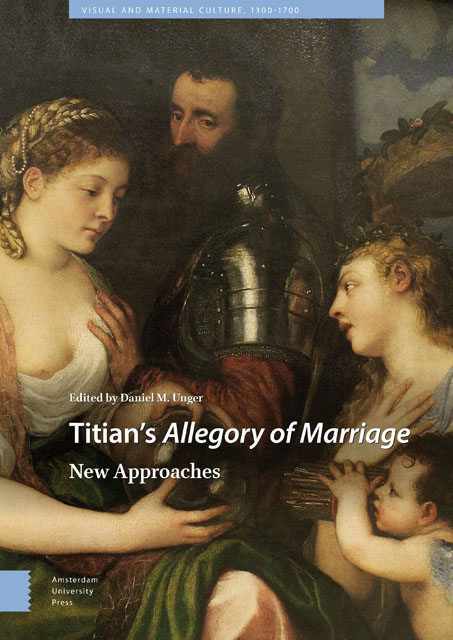Book contents
- Frontmatter
- Table of Contents
- List of Plates and Figures
- 1 Introduction: Poetic License
- 2 Love, Beauty, and the Human Body as a Reflection of the Divine
- 3 Amorosa visione: Titian’s Allegory of Marriage and the Poetry of the Half-length Format
- 4 The Arms and Armour of Titian’s Allegory of Marriage
- 5 ‘Un disio sol d’eterna gloria e fama’: A Literary Approach to Titian’s Allegory
- 6 Psyche, Venus, Ceres and Their Friends: Titian’s Remixes
- 7 Art and the Double Meaning of Reflection in Titian’s Allegory of Marriage
- 8 Titian’s Allegory of Marriage as an ‘Allegory of Peace’
- 9 Vision and Touch in the Allegory of Marriage
- 10 Of Crystal Orbs and Divinatory Mirrors : The Vicissitudes of Pregnancy and Artistic Agency in Titian’s Allegory of Marriage
- Index
10 - Of Crystal Orbs and Divinatory Mirrors : The Vicissitudes of Pregnancy and Artistic Agency in Titian’s Allegory of Marriage
Published online by Cambridge University Press: 16 November 2022
- Frontmatter
- Table of Contents
- List of Plates and Figures
- 1 Introduction: Poetic License
- 2 Love, Beauty, and the Human Body as a Reflection of the Divine
- 3 Amorosa visione: Titian’s Allegory of Marriage and the Poetry of the Half-length Format
- 4 The Arms and Armour of Titian’s Allegory of Marriage
- 5 ‘Un disio sol d’eterna gloria e fama’: A Literary Approach to Titian’s Allegory
- 6 Psyche, Venus, Ceres and Their Friends: Titian’s Remixes
- 7 Art and the Double Meaning of Reflection in Titian’s Allegory of Marriage
- 8 Titian’s Allegory of Marriage as an ‘Allegory of Peace’
- 9 Vision and Touch in the Allegory of Marriage
- 10 Of Crystal Orbs and Divinatory Mirrors : The Vicissitudes of Pregnancy and Artistic Agency in Titian’s Allegory of Marriage
- Index
Summary
Abstract
This chapter focuses on the large transparent orb resting on the lap of the central female figure. In exploring the suggestions made by Hartlaub, and later by Grabski, I suggest that Titian's Allegory of Marriage depicts a contemporary ritual of crystal gazing. I historicize some of the salient natural philosophical, magic/theological, medical, and political aspects that formed a backdrop for such divinatory tools and the rituals in which they were used. In particular, I explore the magical qualities of rock crystal and similar divinatory tools in scrying, and the imbrications between such rituals and pregnancy. I suggest that the Allegory imbricates a ritual of scrying with a particular conception of the power—and limits—of a visual representation.
Key Words: Titian, crystallomancy, mirrors, pregnancy, courtesans, imagination
Introduction
This chapter focuses on the large transparent orb resting on the lap of the central female figure in Titian's Allegory of Marriage (Plate 7). I start with a few hypotheses that guide my reading of the painting. First, I follow some earlier claims that the work represents a ritual of divination: to be more precise that the painting is a rendering of the magical art of scrying or crystal gazing. Erwin Panofsky proposed that the Allegory relates to procreation, sex, and the precarious state of the female pregnant body. Gustav Friedrich Hartlaub maintained that the couple in the Allegory was trying to foretell the future, probably to find out the shape, the sex, or fate of their child (or of some other event). Generally, people engaged in such rituals to foretell the future or to discover an unknown past. Yet, as opposed to Panofsky and Hartlaub, my observations suggest a highly ambivalent mode of pictorial representation of such rituals and its ramifications for pregnancy and the shape and character of a future child in a maternal womb. (In particular, I suggest that the orb in the Allegory is a highly aesthetic representation of the creative powers attendant on a maternal womb.)
As evidence for these suggestions, I highlight some of the salient philosophical, magic/theological, medical, political, and gendered aspects that form the backdrop to crystallomancy and its relationship to similar divinatory tools, such as mirrors, reflecting surfaces, and water and the relationship between these rituals and the bodies of pregnant women, who often acted as scryers.
- Type
- Chapter
- Information
- Titian's Allegory of MarriageNew Approaches, pp. 229 - 250Publisher: Amsterdam University PressPrint publication year: 2022



